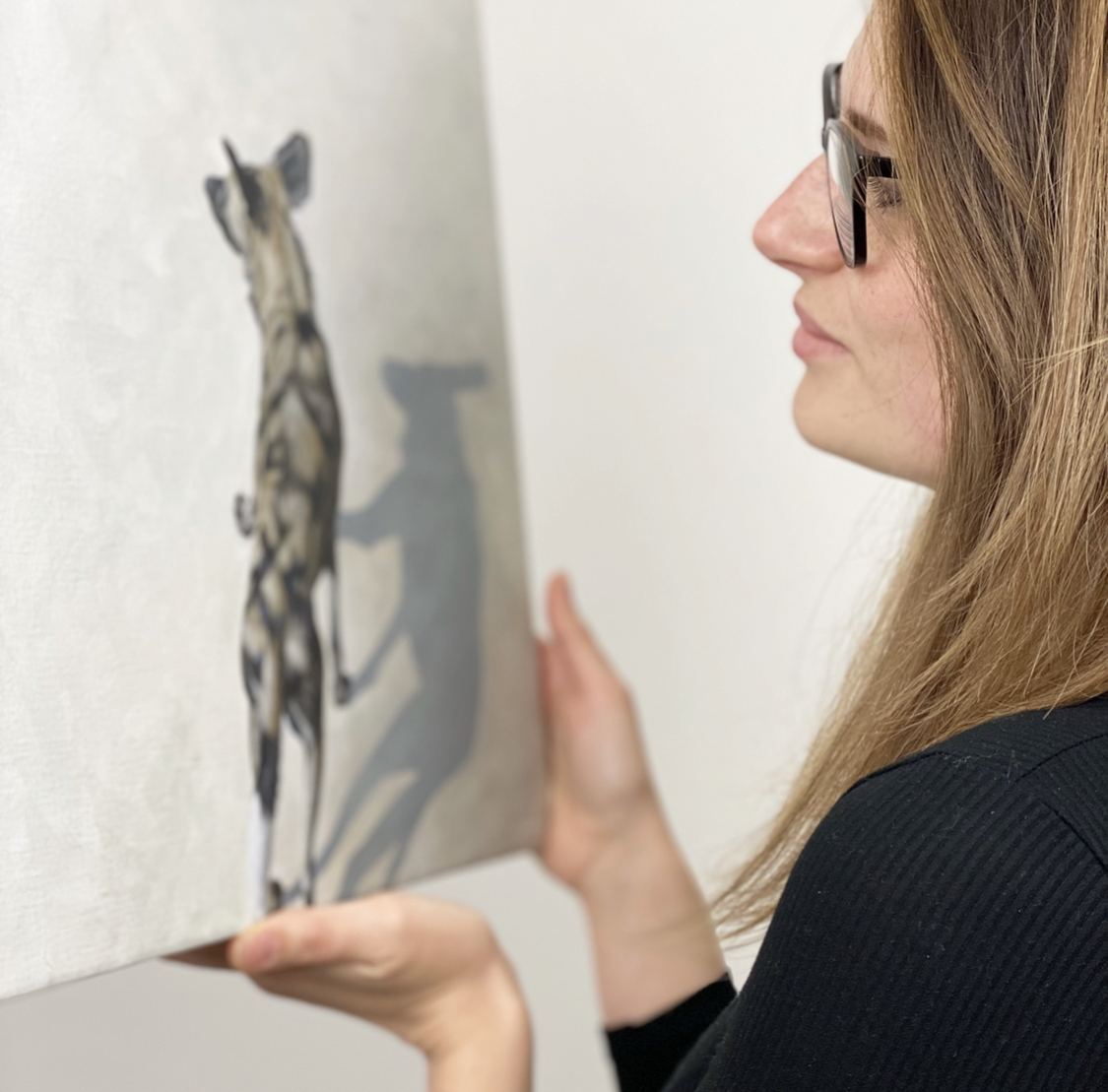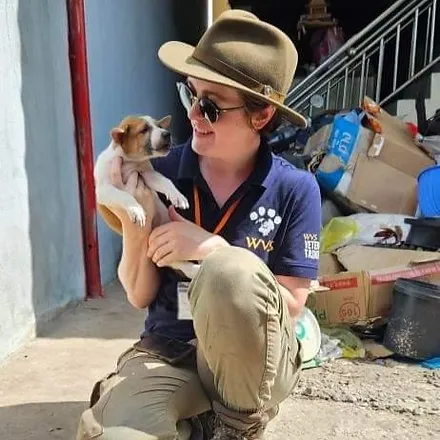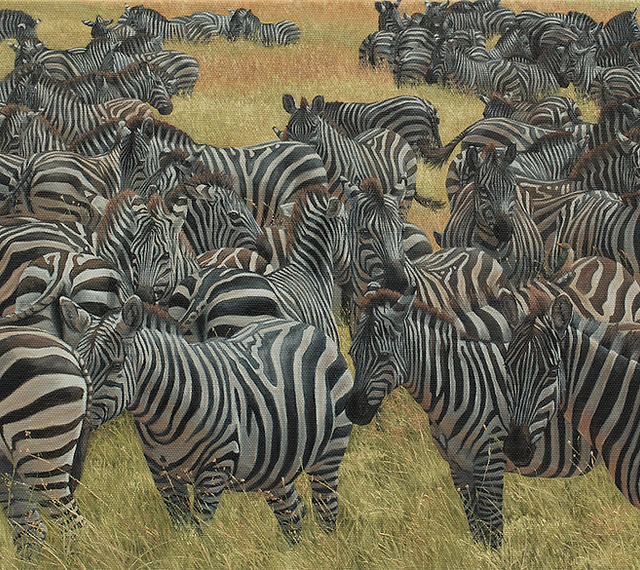Chloë Donovan
- Zoe Fitchet

- Feb 20, 2024
- 7 min read
Artist Bio:

My name is Chloë Donovan and I'm a veterinarian and an animal artist. I am immensely privileged to have a vocation that allows me to explore the world whilst providing veterinary services to animals along my way. My artistic goal is to tell the stories of those animals - sharing my memories and experiences with the viewer, so you feel like you've met these beautiful animals too. I like to use the slogan "bring the wild home", because I want my paintings on your living room wall to be windows into the incredible wild places that exist around the world. I donate a proportion of profits from sales of originals and prints to organisations that operate out in the field to protect animals, and work towards long-term solutions to tackle their greatest threats.
How did you become the artist you are today?
I was one of those kids who was drawing as soon as they could hold a pencil - quite a few of my most vivid memories from the years around first school are to do with drawing. At middle school I would forgo playground time to sit in the classroom and draw dogs with my friend, and at high school any time not spent in the art classroom was time wasted. However I knew that pursuing a career as a vet was what I really wanted to do, so by the time I went to college I had to put art on hold to fill my timetable with science and maths, and then vet school was so intense my sketchbooks were pretty sparse. I bought some oil paints around the time I graduated, but having so little time to practice I would just get frustrated with them, and demotivated. It was actually during lockdown that I sat down with them properly, and spent about £5 on a Udemy beginner course which really helped me to understand the medium. After that I just got obsessed, and the more I was able to execute my ideas the more excited I got. I'm at a place now, 2.5 years down the line, where I think I've found 'my style', and mostly just create art that I want to have on my walls (which is lucky, because that's where it all is!).

How do you support wildlife conservation and why do you choose to do so? The aspect of my veterinary career that I find most rewarding and exciting is the opportunity to get out in the world and make a tangible difference to animals wherever they can be found. I have been fortunate in my career so far to combine my job with my love of adventure travel, and take my vet skills to far flung places. My first foray into international veterinary work was at age 19 when I visited India with the NGO Mission Rabies, to embark on a mass vaccination campaign of street dogs against the deadly virus. A spark was ignited which altered my course forevermore, and I have been grasping every opportunity that arises since. My work has taken me around the globe, from the sparkling coasts of Australia to the vibrant rainforests of Madagascar.
When I started painting semi-professionally it didn't take long for me to make the decision to use my art to continue my support for the charities that I have worked with. Therefore, in addition to the WWF which needs no introduction, there are a number of veterinary and conservation based NGOs which I am proud to continue to support beyond the point at which I board my homeward flight. By donating a proportion of profits from sales of selected artworks, in addition to donating my time by volunteering out on the ground, real animals in need can be helped.
It is important to me that I don't just use the image of an animal for my own benefit - if I use a photographer's reference image I pay them, but the animal gets nothing. If I am to use their likeness then I want them to benefit in some way too. By donating a proportion of profits to these NGOs I know that the animals are getting a form of payment; whether it be helping to fund veterinary care that directly helps them, or conservation projects that benefit the species or ecosystem on a wider level.

Most recently I spent 6 weeks in Bhutan supporting an animal rescue charity. Most of the work revolved around domestic dogs and cats but any species in need got help. 2 out of 5 of the surgeries I undertook were wildlife casualties which was so rewarding because it is very likely that without that intervention I was able to provide both would have died. The veterinary profession is really tough, especially in small animal clinics in the UK - and not for the reasons people assume (mostly because of the people...), so having the opportunity to go and use my skills to actually benefit animals in real need around the world is probably the only reason I'm still in the job.
What is your favourite/ most enjoyable part of being a wildlife artist?
I love making the art that I would want to buy, bringing it into existence. I'm having a lot of fun at the moment with a popart-esque series of African herbivores all painted in a photorealistic style on really bold colourful backgrounds. I'm also really excited about bringing some of my travelling memories to canvas, creating epic scenes of some of the incredible landscapes I've been lucky enough to see with my own eyes.
What has been your biggest learning curve as an artist? There's one painting, a scene of a cheetah family in the savannah at dusk, that took me over 2 years to paint. I planned out the composition using thumbnails based on various references from Kenya, zoos and various other places, mapped it out on the canvas, then got totally stuck. I realise now that at the time it was just too advanced for me at that stage. I went back to it about 5 times, each time with new tricks up my sleeve, but never quite enough. I ended up abandoning it for about a year, and just before going back to it I used photoshop to experiment in a less messy way than going straight to the canvas with half-baked ideas. This time it finally came together, and the painting came out better than I imagined, I'm so happy with it. Looking back at my original composition there's a lot that I wouldn't have chosen to do now, and even with the final layers I still wasn't really able to deviate much from that composition without completely starting again, but that's ok. Not every painting has to be perfect, and every painting teaches so much. I am a big fan of Andrew Tischler's teachings, and one of the terms he uses a lot is "brush mileage". I think that's really key - you just have to keep painting, there are no shortcuts.

[Cheetahs]
'In The Morning She Walks Alone'
Oil on canvas, 18x24"
Cheetahs (classified as Vulnerable on the IUCN Red List) are found in only a fraction of their former range that spread across Africa, the Arabian peninsula and the Indian subcontinent. In many areas the survival rate of cheetah cubs is just 5%, meaning that statistically, the 3 cubs in this painting would not reach adulthood. Outside of nature reserves many are killed in human conflicts, starve, or are trafficked by poachers. Within the reserves many cubs are killed by rival predators, often lions. So even though here, as the sun sets, the family have a meal to eat in a beautiful peaceful land, there's no guarantee that the sun will rise on the same idyllic scene...
Which species are you most involved or interested in supporting through conservation projects?
I like to try and support the projects I've worked with - I've seen first hand the work they do, and know how much a lot of animal-based charities struggle to get by. People always seem surprised when I say I don't get paid when I work as a vet overseas - but there really is very little funding for animal health and welfare, because very few people really care or take real responsibility for animals. Some are lucky and get government funding but most rely on goodwill and donations to cover their overheads, food and medicine costs which can be very high.
NATUWA wildlife sanctuary, Costa Rica
The Mad Dog Initiative, Madagascar
The Himalayan Animal Rescue Trust, Nepal
Bhutan Animal Rescue and Care, Bhutan
Lewa Wildlife Conservancy, Kenya
VetAid, Kenya
The Worldwide Veterinary Service
If you were an animal, what would you be and why? A bear. What a perfect life.
What is the best piece of advice you could give an aspiring wildlife artist? Try not to make the same work as everyone else - there are so many almost identical pieces flooding instagram, wildlife art shows etc. Not everyone is in a position to take their own reference photos in the wild, and not everyone has a good enough camera/luck to get good photos in zoos, but there are so many royalty-free reference photos out there to choose from. Try and find your own niche and style, look to old Masters for inspiration and most importantly, look to nature. I find that the vast majority of conservation focused wildlife art features animals completely divorced from their natural habitat, which I feel is a bit ironic given that that is a huge reason as to why these species are struggling in real life. Not every piece has to be super meaningful or 10/10, the most important thing is to have fun, but if you want to make a name for yourself I think it's important to steer away from the regular stereotypes.










Comments